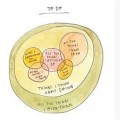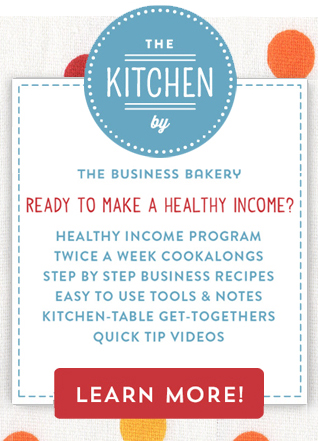How to stop selling yourself short. Our 7 step recipe
Written by Julia Bickerstaff // January 15, 2013 // Daily Juice // No comments
“I’m going to stop selling myself short”. Golly that would make a good mantra for many of us. We do it a lot you know. Sell ourselves short, undervalue what we do, underprice our stuff.
So this week, a recipe to help you value your work and price a little higher.
This recipe is written especially for those of you who sell homemade and handmade stuff. So if you’re a cakey type, jewellery maker, or particularly deft with a sewing needle, this is for you. If you’re not a cook or crafter it’s still worth taking a peek as the principles work for everyone.
This isn’t a recipe that tells you how to price but rather it’s a technique that will help – maybe even force – you to banish your pricing collywobbles and charge a little more for the awesome stuff you make.
Take a deep breathe and give this a go.
This is a technique to help you think about the value of your time. I’m not saying you have to use this to calculate the actual price you charge but rather, as you’ll see, it’s a useful way to help you keep your pricing up.
Here’s what you do:
- Decide how much profit you would like your business to make this this year.
Not sure how to do this? Here’s some help.
- Add to that an amount for admin and marketing
Take your profit figure and add in a rough amount for what you spend on overheads and marketing. Basically just add in anything that’s not a product cost. Don’t worry about being exact. A guesstimate is good enough. Let’s call the total ‘Big Profit’.
- Work out how many hours a week you can spend actually making your product.
To do this think about:
- The number of hours a week you have available for work
- The number of hours a week you need to spend on marketing
- The number of hours a week you need to spend on ‘admin’ and other non-making work.
My friend Amber spends about 35 hours a week working but 10 of those are on marketing and 5 on admin so she only spend 20 hours a week ‘making’. If you’re not sure how many hours a week you spend on the different parts of your business try keeping a timesheet for a couple of weeks and record where you spend your time.
- Calculate the value of your time*.
Just take your Big Profit number and divide it by the number of hours you spend making your product to get a value for your time
So let’s say Amber’s Big Profit is $100,000 a year. She works 50 weeks a year and spends about 20 hours a week on making her product. So that’s roughly 1000 hours a year making stuff.
Which means Amber would value her time as 100,000/1000= $100 per hour.
- Now work out the ‘time cost’ of your product.
You do this by multiplying the number of hours you spend making a single unit of product by your hourly cost.
It takes Amber 2 hours to make her product so the time cost of each unit of product is 2X100= $200.
- Now work out the total ‘cost’ of your product.
I’m assuming here that you know what the cost of the ingredients (or materials) for each of your product is. If you don’t, it’s probably worth having a think about that now. Again don’t worry about being super-exact, having just a rough idea is fine.
Now just add the ingredients cost of your product to the ‘time cost’ of your product.
Amber’s product cost is $50 so her total cost is 50+200=$250
- Write your total cost down somewhere very visible to you (but not your customers!)
Now, the point of the ‘total cost’ is this. If you sell your product for less than your ‘total cost’ you won’t make the profit you want.
Well yes. You could work longer hours and make more product and make your profit that way. But if you want to work the hours you’re currently working you need to price your product equal to or higher than your total cost.
So pop the ‘total cost’ on a big bit of paper and stick it on the wall. And whenever you get the pricing collywobbles just glance at the piece of paper and say: if I want to make a healthy income I need to price higher than that!
* For those of you who want to know. This shortcut is based on ‘making’ hours because they are the only ones you get paid for.
Pricing itself is a mammoth topic. We’ve got lots of pricing articles here on the Daily Juice; here’s a small sample:
How to be persuasive with your pricing
Thoughts on quantity discounts
Funny little pricing tip that really works!
Pricing for wimps: should I charge the same as my competitors
Four pricing lessons from Business Chicks

Fancy getting a weekly Snack of sweet stuff for your small business? Just pop your details in below.






















